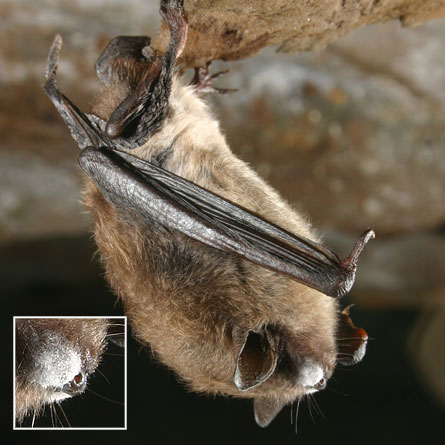A mold that gives hibernating bats fuzzy, white noses turns out to be a previously unknown form of cold-loving fungus. And it may be a cold-blooded killer too.

A novel form of a Geomyces fungus ranks as a possible cause of the deadly white-nose syndrome recently described in New England bats, David Blehert of the U.S. Geological Survey’s National Wildlife Health Center in Madison, Wisc., and his colleagues report online October 30 in Science.
White-nose syndrome, described only in the last two years, strikes its victims during their winter hibernation. Bats cuddled along the walls of caves or mines develop a white fuzz on their noses and wings, grow gaunt and then die.
A recreational explorer’s photograph from Howes Cave west of Albany, N.Y., in February 2006 provides the first record of the syndrome, Blehert says. Five sites turned up in New York state the next winter, and 33 in four states in winter of 2007.
“The bat community is alarmed,” says Marianne Moore of Boston University, who studies bat immunology. The syndrome has hit at least six species, including the widespread little brown bat and the endangered Indiana bat.
Hibernation sites struck by the syndrome lose 80 to 100 percent of their bats on average, Moore says. Northeastern bats hunt insects, including some pests, she says, so a sudden bat deficit “could be a huge problem.”
Knowing at last what the fungus is will let biologists develop screens to search for it and see if it’s the cause or just an opportunistic mold attacking a weak animal, says Blehert.
Culturing and identifying the fungus causing the white nose-fuzz wasn’t easy, Blehert says. When researchers first took samples from stricken bats to grow on lab dishes, many microorganisms appeared but none was consistently linked to the sick animals. Researchers reluctantly decided to try refrigerating their lab cultures; the chill mimics cave conditions but slows down microbial growth.
The strategy worked though, as a Geomyces fungus gradually appeared, flourishing at between 5 and 10 degrees Celsius. It had spores in a fat-banana shape that researchers had never seen before. The mold showed up in most of the bats sampled and matched spore scrapings prepared directly in the caves.
Other molds grow at low temperatures, as the neglected corners of any office refrigerator will prove. What’s unusual about the new Geomyces mold is that it won’t tolerate higher temperatures, Blehert says.
Human noses, for example, are way too warm and probably too active for the fungus. In hibernation though, “a bat for all practical purposes is almost dead,” Blehert says. The heart rate of an alert bat, some 700 beats per minute or more, drops to about four beats per minute during hibernation, and its body chills to only a few degrees above the ambient temperatures in the cave.
That’s good news for bats that migrate or live far to the south. Northern hibernating species, however, could be at risk from the possible spread, he says.






